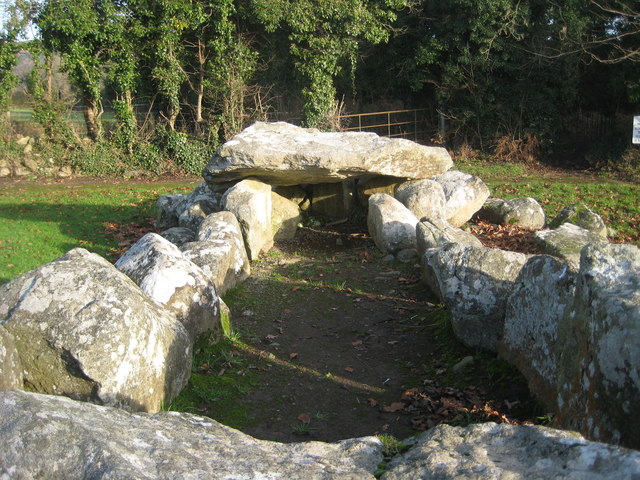Proleek Dolmen on:
[Wikipedia]
[Google]
[Amazon]
Proleek Dolmen is a dolmen (portal tomb) and National Monument located in County Louth,
 The dolmen dates to the
The dolmen dates to the
 Proleek dolmen is composed of two portal stones, a lower backstone and a massive capstone, which weighs about 40 tonnes. The portal faces northwest.
90 metres (100 yd) to the SE is a
Proleek dolmen is composed of two portal stones, a lower backstone and a massive capstone, which weighs about 40 tonnes. The portal faces northwest.
90 metres (100 yd) to the SE is a
Ireland
Ireland ( ; ga, Éire ; Ulster Scots dialect, Ulster-Scots: ) is an island in the Atlantic Ocean, North Atlantic Ocean, in Northwestern Europe, north-western Europe. It is separated from Great Britain to its east by the North Channel (Grea ...
.
Location
Proleek Dolmen is northeast ofDundalk
Dundalk ( ; ga, Dún Dealgan ), meaning "the fort of Dealgan", is the county town (the administrative centre) of County Louth, Ireland. The town is on the Castletown River, which flows into Dundalk Bay on the east coast of Ireland. It is h ...
, on the west bank of the Ballymascanlan River.History
 The dolmen dates to the
The dolmen dates to the Neolithic
The Neolithic period, or New Stone Age, is an Old World archaeological period and the final division of the Stone Age. It saw the Neolithic Revolution, a wide-ranging set of developments that appear to have arisen independently in several p ...
, around 3000 BC. It was used for interments in which the cremated remains were placed in the tomb, often accompanied by grave goods
Grave goods, in archaeology and anthropology, are the items buried along with the body.
They are usually personal possessions, supplies to smooth the deceased's journey into the afterlife or offerings to the gods. Grave goods may be classed as a ...
, including tools, beads
A bead is a small, decorative object that is formed in a variety of shapes and sizes of a material such as stone, bone, shell, glass, plastic, wood, or pearl and with a small hole for threading or stringing. Beads range in size from under ...
and pottery
Pottery is the process and the products of forming vessels and other objects with clay and other ceramic materials, which are fired at high temperatures to give them a hard and durable form. Major types include earthenware, stoneware and ...
. The tomb may be aligned so that its portal points toward Slieve Gullion
Slieve Gullion ( or ''Sliabh Cuilinn'', "Culann's mountain") is a mountain in the south of County Armagh, Northern Ireland. The mountain is the heart of the Ring of Gullion and is the highest point in the county, with an elevation of . At the ...
and/or the setting sun at the summer solstice.
Local legend claims that the dolmen was carried here by the Scottish giant Para Buidhe Mór Mhac Seoidin (or Parrah Boug MacShagean; "Great Yellow Para, son of Seoidín"). Para challenged Fionn mac Cumhaill
Fionn mac Cumhaill ( ; Old and mga, Find or ''mac Cumail'' or ''mac Umaill''), often anglicized Finn McCool or MacCool, is a hero in Irish mythology, as well as in later Scottish and Manx folklore. He is leader of the ''Fianna'' bands of y ...
to combat, but Fionn poisoned the nearby river and Para drank from it. The Scottish giant was buried at the wedge tomb nearby.
Another local tradition claims that if a visitor lands three stones atop the dolmen, they will be granted a wish, or will be married within the year.
Description
 Proleek dolmen is composed of two portal stones, a lower backstone and a massive capstone, which weighs about 40 tonnes. The portal faces northwest.
90 metres (100 yd) to the SE is a
Proleek dolmen is composed of two portal stones, a lower backstone and a massive capstone, which weighs about 40 tonnes. The portal faces northwest.
90 metres (100 yd) to the SE is a Wedge-shaped gallery grave
A gallery grave is a form of megalithic tomb built primarily during the Neolithic Age in Europe in which the main gallery of the tomb is entered without first passing through an antechamber or hallway. There are at least four major types of galle ...
("Giant's Grave") with a gallery.
References
{{Reflist National Monuments in County Louth Archaeological sites in County Louth Dolmens in Ireland Tombs in the Republic of Ireland